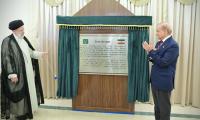ISLAMABAD: Finance Minister Asad Umar on Monday said that the country’s economy was out of the ICU now and it has been shifted to the stabilisation ward now.
Speaking to media persons while launching the draft of medium-term macroeconomic framework from 2018-19 to 2022-23 here, Asad Umar said the PTI government inherited a "very sick patient" that had been taken out of the ICU (Intensive Care Unit). “The government, therefore, had to take emergency measures,” he said.
Asad Umar said the debt to GDP ratio would be envisaged at 70 percent of GDP under the PTI rule till 2022-23, indicating that the debt burden would continue to persist in years to come.
“The people of Pakistan are paying price of imbalances on the economic front as undertaking of basic reforms and adjustments are causing heavy toll in terms of escalation in inflationary pressures. It will be time-consuming to fix these problems,” the minister said. While giving prescription to fix three major economic challenges including yawning fiscal deficit, current account deficit and savings-investment gap, the minister said the phase of economic crisis was over, but stabilisation was ongoing and required one-and-a-half years more to achieve the results. He said the fiscal position crossed risky lines as primary deficit stood at negative 2.2 percent of GDP equivalent to Rs800 billion. This alarming deficit, he said, clearly demonstrated that the situation might get worse. He mentioned the name of the FBR Chairman Jehanzeb Khan and stated that everyone was relying upon him. He said the government was borrowing more to pay interest of already obtained loans.
Asad Umar made it clear that he would not tell a lie as the debt to GDP ratio would be standing at 70 percent of the GDP by end of the PTI tenure in 2023 from existing level of close to 80 percent as the fiscal deficit would have to be brought at sustainable level.
The exports could fetch $40 billion under five-year rule of the PTI-led regime. Asad Umar claimed that the real GDP growth would be highest in 15 years on the terminal year of 2022-23 when the PTI-led regime would complete its five-year term. He said that without improving governance system, no reforms could be undertaken in the country.
The minister made commitment to abolish discretionary supplementary grants without approval of the parliament from next fiscal year. “The role of Finance Ministry as authoritarian Thanadari would be curtailed,” he added.
Asad Umar said the financial discipline has broken down and now the government was bringing new law on public finance management. He said that the next finance minister after five years would not be telling reasons for another balance of payment crisis and having no other option but go back to the IMF programme. “It is not the plan of any political party, but plan of the country to come out from morass,” he added.
The minister said that the government was not sharing figures of its macroeconomic framework because the negotiations with the IMF had entered into final stages and after striking staff-level agreement, all macroeconomic figures would be shared with the public.
“If we continued taking decisions on consideration of elections cycle instead of taking care of our next generations, then nothing substantial for improvement could be achieved,” he added.
He said that Pakistan’s economy was facing three major problems including revenue-expenditure gap called fiscal deficit, current account deficit and finally savings-investment gap. He said that the current account deficit had peaked to $19 billion and he had seen in last 40 years that different countries had surpassed us as countries like China, Korea, Hong Kong lagged behind us and then India and now Bangladesh had gone ahead of us.
Earlier, he said, the African region was attributed as worst, but now half of its countries’ growth was more than Pakistan’s. “Pakistan’s exports slashed 50 percent as it stood at 13.5 percent of GDP in 2003, but now it nosedived to 8 percent of GDP last financial year,” he added. The minister said exports of Bangladesh stood at 15 percent of GDP, India 19 percent of GDP, Turkey 25 percent and Vietnam 102 percent of GDP. The savings in terms of GDP ratio stood at 10 percent while it stood at 30 percent in Bangladesh, 35 percent in India and 45 percent in China. “The investment to GDP ratio in Pakistan is standing at 15 percent while it is more than 30 percent in Vietnam,” he mentioned.
On revenue-expenditure gap, he said that it was far away to run the affairs of the defence and development, but now the situation had come when the government was borrowing more to pay the interest of already obtained loans.
On asset declaration scheme, the minister said that it could not become successful if people were not sure that the law of land would move against them. “I want to tell it that this upcoming amnesty should be availed and no one should complain afterwards,” he added.
Asad Umar said the real effective exchange rate struck equilibrium as it is being done on the basis of economic fundamentals instead of political considerations. He said that the employment opportunities would be generated and poverty would be brought down through Ehsas programme.
Awami Muslim League chief appeared in the court with his lawyers Sardar Raziq and Sardar Shehbaz
Board meeting also allowed increase in business center and commercial area of hotel plots from 5 to 10 percent along...
Foreign exchange reserves currently stand at $8 billion, while Pakistan would also receive $1.1 billion IMF tranche:...
CM directed that the enforcement authorities be made functional in six months, and legislation in this regard be...
Pakistani soldiers and policemen stand guard outside the Haripur central jail. — AFP/FileWASHINGTON: The Pakistani...
Establishment Division has also issued an NoC to fill 465 civilian posts in the Ministry of Defence and 11 posts in...







